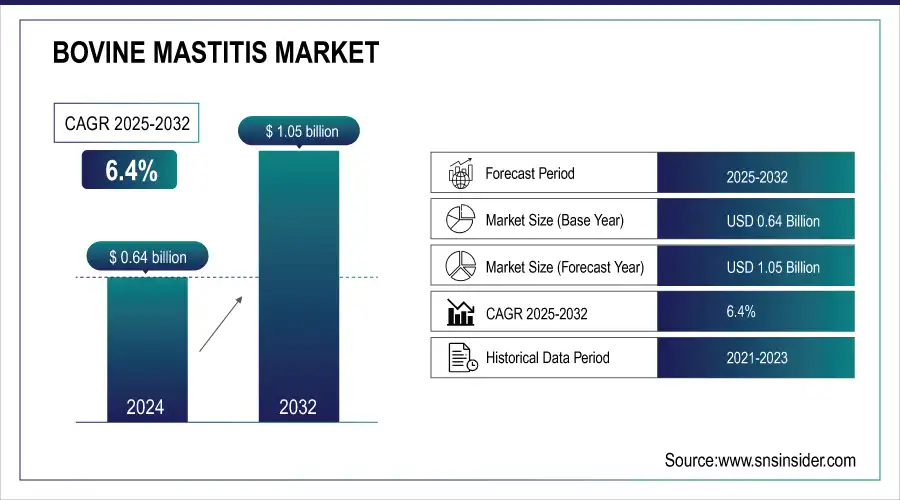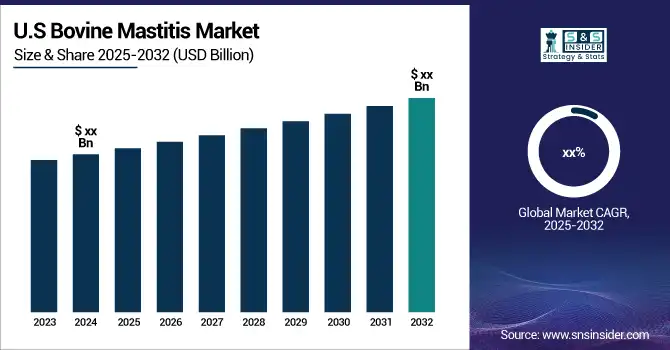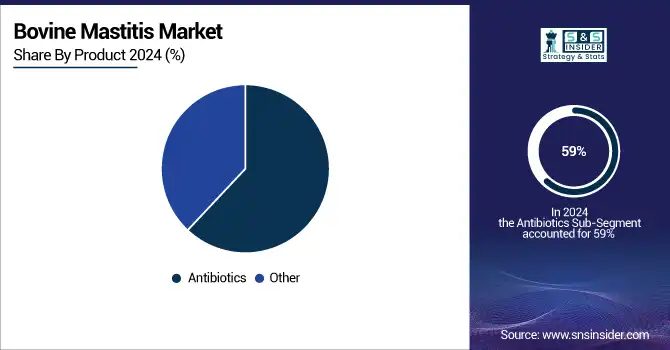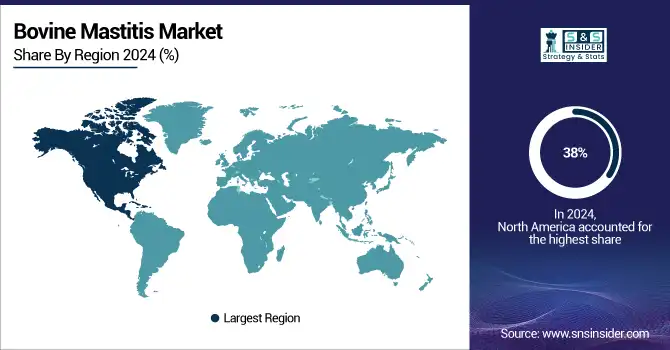Bovine Mastitis Market Report Scope & Overview:
The Bovine Mastitis Market size was USD 0.64 Billion in 2025E and is expected to reach USD 1.05 Billion by 2033 and grow at a CAGR of 6.4% over the forecast period of 2026-2033.
Bovine Mastitis Market Size and Forecast:
-
Market Size in 2025E: USD 0.64 Billion
-
Market Size by 2033: USD 1.05 Billion
-
CAGR: 6.4% from 2026 to 2033
-
Base Year: 2025
-
Forecast Period: 2026–2033
-
Historical Data: 2022–2024

To Get More Information on Bovine Mastitis Market - Request Sample Report
Key Bovine Mastitis Market Trends:
-
Rising awareness among dairy farmers about the impact of udder health on milk yield and quality drives adoption of mastitis prevention and treatment solutions.
-
Increasing use of advanced diagnostic tools, including somatic cell count monitoring and automated sensors, enables early detection and timely intervention, reducing economic losses.
-
Strict government regulations on antibiotic usage and residue limits in milk encourage the development and adoption of alternative therapies and preventive measures.
-
Growing dairy production and consumption in emerging regions create opportunities for market expansion, with increased demand for vaccines, antibiotics, and hygiene products.
-
Integration of herd management software and IoT-based monitoring enhances disease tracking, operational efficiency, and herd productivity.
-
Rising investments in veterinary healthcare infrastructure and training programs improve accessibility to mastitis management solutions.
-
Focus on sustainable and residue-free milk production accelerates adoption of non-antibiotic treatments and preventive practices.
The U.S. Bovine Mastitis market size was valued at an estimated USD 0.22 billion in 2025 and is projected to reach USD 0.36 billion by 2033, growing at a CAGR of 6.3% over the forecast period 2026–2033. Market growth is driven by the high prevalence of mastitis in dairy cattle, increasing focus on animal health and milk quality, and the growing demand for dairy products across the country. Rising adoption of advanced diagnostic tools, improved veterinary treatment solutions, and preventive herd management practices are supporting market expansion. Additionally, increasing awareness among dairy farmers, supportive government initiatives for livestock health, and continuous innovation in veterinary pharmaceuticals further contribute to the steady growth of the U.S. bovine mastitis market during the forecast period.
The global market for products and services related to the prevention, diagnosis, and treatment of bovine mastitis in dairy cows is referred to as the bovine mastitis market. Bovine mastitis is a common and economically significant illness that affects dairy cattle all over the world. It is characterized by inflammation of the mammary glands, leading to reduced milk production, quality issues, and potential animal welfare concerns. The pharmaceuticals segment includes antibiotics and other medications used to treat bovine mastitis infections. Several antimicrobial agents and intramammary products are available for the treatment of mastitis. Diagnostic tools and tests, such as somatic cell count tests and bacteriological culture tests, are used to identify and differentiate mastitis-causing pathogens. Vaccines have been developed to prevent or reduce the severity of mastitis in dairy cows.

Bovine Mastitis Market Drivers:
-
The demand for milk and dairy products continues to rise due to population growth, changing dietary preferences, and increased urbanization.
-
Growing Awareness of Dairy Cow Health is the major driver of this market.
There is a rising recognition among dairy farmers that cow health directly influences both milk yield and quality. Mastitis, an inflammation of the mammary gland, is one of the most common and economically damaging diseases in dairy cattle. It not only reduces milk production but also affects milk composition, leading to financial losses due to discarded milk, veterinary expenses, and decreased farm efficiency. To mitigate these impacts, farmers are increasingly adopting preventative strategies such as proper milking hygiene, regular udder health monitoring, and nutritional management. Early detection tools, including somatic cell count monitoring and automated health sensors, are being integrated into herd management practices. These proactive measures help maintain herd productivity, improve milk quality, and optimize overall dairy farm profitability.
Bovine Mastitis Market Restraints:
-
The overuse or misuse of antibiotics for the treatment of bovine mastitis has contributed to the development of antibiotic-resistant bacteria.
-
The primary limitations in this industry are stringent regulations.
Governments and regulatory authorities are increasingly enforcing strict rules on the use of antibiotics and pharmaceuticals in the dairy industry to ensure food safety and public health. These regulations often limit the types, dosages, and duration of antibiotic treatments, while setting stringent maximum residue limits in milk. As a result, dairy farmers face challenges in effectively managing mastitis, a common and costly udder infection. Reduced access to conventional antibiotics can delay treatment, potentially worsening animal health and decreasing milk yield and quality. To comply with regulations while maintaining herd productivity, farmers are turning to alternative strategies such as preventive healthcare, improved hygiene practices, vaccination programs, and non-antibiotic therapies, balancing regulatory adherence with economic and operational efficiency.
Bovine Mastitis Market Opportunities:
-
Continued research and development in diagnostic technologies can lead to the introduction of more rapid, accurate, and cost-effective mastitis detection methods.
-
The greatest potential for this industry is a market expansion in emerging regions.
The bovine mastitis market presents significant growth opportunities in emerging regions where dairy production and consumption are on the rise. As developing countries modernize their dairy farming practices, including better herd management, milking hygiene, and veterinary care, the need for effective mastitis prevention and treatment solutions is increasing. Rising awareness among farmers about the economic losses caused by mastitis, such as reduced milk yield and quality, drives the adoption of antibiotics, vaccines, and diagnostic tools. Additionally, government initiatives supporting dairy development and improving animal health infrastructure further stimulate market demand. Consequently, emerging markets are becoming key growth areas for mastitis-related products, offering manufacturers and service providers the potential to expand their presence and revenue streams in these regions.
Bovine Mastitis Market Segmentation Analysis:
By Product, the Antibiotics Segment Dominates the Bovine Mastitis Market in 2025, and the Other Therapies Segment Exhibits the Fastest Growth in the Bovine Mastitis Market
The Antibiotics segment dominated the bovine mastitis market with the largest revenue share of 59% in 2025. This dominance is due to the widespread use of antibiotics to treat and prevent mastitis infections, which directly improves milk yield and quality. As dairy farmers prioritize herd health, demand for effective antibiotic treatments rises. Continuous product development, including novel formulations and residue-safe antibiotics, further strengthens market growth, ensuring reliable treatment options and reinforcing the central role of antibiotics in mastitis management. The Other segment is growing at the highest CAGR during the forecast period. This surge is driven by increasing adoption of non-antibiotic therapies, including herbal treatments, probiotics, and vaccines. As regulatory restrictions on antibiotics tighten, farmers seek alternative solutions that maintain udder health without compromising milk safety. Innovation in preventive care and product development accelerates adoption, expanding the market for diverse mastitis management options and supporting sustainable, residue-free dairy production.

By Route of Administration, Intramammary Administration Leads the Bovine Mastitis Market in 2025, Systemic Administration Shows the Highest CAGR in the Bovine Mastitis Market
The Intramammary segment dominated the bovine mastitis market with the largest revenue share of 53% in 2025. This is due to its direct application to the udder, ensuring rapid and targeted treatment of infections. The effectiveness of intramammary therapies in reducing infection duration and improving milk quality drives higher adoption among dairy farmers. Ongoing product development of intramammary formulations with improved efficacy, reduced withdrawal periods, and ease of administration further fuels market growth, reinforcing its leading position in mastitis treatment. The Systemic segment is growing at the fastest CAGR of 13.71% during the forecast period in 2026-2033. The growth is driven by increased demand for whole-body treatment options for severe or multiple-quinolone infections. Systemic antibiotics provide widespread therapeutic coverage, ensuring rapid recovery and minimizing production losses. Advancements in drug formulations, including long-acting injectables and improved bioavailability, support efficient treatment protocols. Consequently, systemic administration is gaining traction among dairy farmers, contributing to the expanding market for comprehensive mastitis management solutions.
By Application, On-site Treatment Commands Largest Revenue Share in Bovine Mastitis Market, Veterinary Clinics and Hospitals Segment Growing Fastest in Bovine Mastitis Market
The On-site Treatment segment dominated the bovine mastitis market with the largest revenue share of 47% in 2025. This dominance stems from the convenience and immediacy of treating cows directly on the farm, reducing infection spread and milk loss. Dairy farmers increasingly prefer on-site interventions combined with monitoring tools to ensure herd health. Continuous development of easy-to-administer, rapid-acting products enhances treatment efficiency, further strengthening the market for on-site mastitis management and supporting improved dairy productivity. The Veterinary Clinics and Hospitals segment is growing at the fastest CAGR during the forecast period. The growth is fueled by rising veterinary awareness and increasing reliance on professional expertise for complex or recurring mastitis cases. Clinics provide advanced diagnostic services, treatment guidance, and access to specialized medications, ensuring effective management of infections. Investments in veterinary infrastructure, coupled with product innovations and professional training programs, drive adoption of clinic-based care, contributing to the expanding market for professional bovine mastitis management solutions.
Bovine Mastitis Market Regional Analysis:
North America Dominates the Bovine Mastitis Market in 2025
North America holds an estimated 38% market share in 2025, driven by high adoption of advanced dairy farming practices, precision livestock monitoring, and veterinary services. This causes farmers to invest heavily in mastitis prevention and treatment solutions, improving milk quality and herd health while boosting demand for antibiotics and alternative therapies.

Do You Need any Customization Research on Bovine Mastitis Market - Enquire Now
-
United States Leads North America’s Bovine Mastitis Market
The U.S. dominates the North American market due to its large-scale, technologically advanced dairy farms and strong veterinary infrastructure. High milk production volumes and stringent quality standards increase the need for effective mastitis management solutions. Government initiatives supporting dairy health programs and research in veterinary pharmaceuticals further drive adoption. Additionally, U.S. dairy farmers increasingly use intramammary treatments, systemic antibiotics, and on-site interventions, creating steady demand for both traditional and innovative mastitis products, reinforcing the country’s leadership in the regional market.
Asia Pacific is the Fastest-Growing Region in Bovine Mastitis Market in 2025
The region is expected to grow at a CAGR of 8.9% from 2026–2033, driven by modernization of dairy farms, rising milk consumption, and increased awareness of herd health. This causes adoption of advanced mastitis management solutions, including antibiotics, alternative therapies, and veterinary services.
-
India Leads Asia Pacific’s Bovine Mastitis Market
India dominates the Asia Pacific market due to its position as one of the largest milk producers globally. Rapid growth in commercial dairy farming, government initiatives promoting livestock health, and adoption of modern treatment practices accelerate market expansion. Increasing awareness among farmers about mastitis impact on milk yield and quality drives demand for antibiotics, herbal remedies, and intramammary therapies. Investment in veterinary clinics and on-site treatment options further strengthens the market, positioning India as the leading contributor to the region’s bovine mastitis growth.
Europe Bovine Mastitis Market Insights, 2025
Europe shows steady growth in bovine mastitis solutions, supported by high-quality dairy production and strict milk safety regulations. The U.K.’s focus on herd health programs and antimicrobial stewardship improves dairy productivity, causing increased adoption of mastitis management solutions.
-
Germany Leads Europe’s Bovine Mastitis Market
Germany dominates Europe’s market due to advanced dairy farm infrastructure, high milk output, and rigorous quality standards. German farmers emphasize preventive care, including intramammary therapies, systemic antibiotics, and innovative alternatives. Government support for veterinary research, antimicrobial monitoring, and residue-free milk production further encourages adoption. Continuous product development and availability of professional veterinary services ensure effective mastitis management, solidifying Germany’s leadership in Europe’s bovine mastitis market.
Middle East & Africa and Latin America Bovine Mastitis Market Insights, 2025
The bovine mastitis market in these regions is expanding moderately, driven by rising dairy consumption, modernization of dairy farms, and increasing awareness of herd health. Countries like Brazil and Mexico invest in veterinary services and preventive care, while the UAE and South Africa focus on herd management technologies and on-site treatments. Growing dairy production, combined with demand for safe, high-quality milk, is encouraging adoption of antibiotics, intramammary therapies, and alternative mastitis solutions. International partnerships and product innovations support steady market growth across these regions.
Competitive Landscape for Bovine Mastitis Market:
Zoetis Inc.
Zoetis Inc. is a U.S.-based global leader in animal health, specializing in vaccines, antibiotics, and therapeutic solutions for livestock, including bovine mastitis management. With decades of experience, the company develops, manufactures, and markets products that enhance herd health, milk quality, and disease prevention. Zoetis operates worldwide, supporting farmers with veterinary expertise, on-site services, and comprehensive treatment protocols. Its role in the bovine mastitis market is vital, as it provides innovative, effective solutions that reduce infection rates, improve productivity, and ensure sustainable dairy farming practices.
-
In 2024, Zoetis expanded its mastitis portfolio with advanced intramammary formulations and residue-safe antibiotics, targeting higher efficacy and faster recovery in dairy herds.
Merck Animal Health (MSD)
Merck Animal Health (MSD) is a global leader in veterinary pharmaceuticals and vaccines, offering comprehensive solutions for bovine mastitis prevention and treatment. The company focuses on antibiotics, immunotherapies, and diagnostic tools to enhance herd health and milk production. Merck collaborates with dairy farmers and veterinary professionals to implement effective treatment protocols, ensuring improved outcomes. Its role in the bovine mastitis market is significant, driving innovation and sustainable management practices that reduce economic losses from infections.
-
In 2024, Merck launched new mastitis vaccines and intramammary therapies designed to lower infection recurrence and enhance milk safety, supporting farmer adoption of integrated herd health programs.
Boehringer Ingelheim
Boehringer Ingelheim is a Germany-based multinational specializing in animal health products, including mastitis control solutions for dairy cattle. The company provides antibiotics, vaccines, and preventive care tools to enhance herd immunity and milk quality. Boehringer Ingelheim works closely with veterinarians and farmers to optimize treatment protocols and promote sustainable dairy farming practices. Its role in the bovine mastitis market is critical, offering reliable, innovative products that reduce infection prevalence and increase operational efficiency.
-
In 2024, Boehringer Ingelheim introduced advanced intramammary treatments with faster action and reduced withdrawal periods, improving compliance and productivity in commercial dairy operations.
Elanco Animal Health
Elanco Animal Health is a U.S.-based animal health company delivering vaccines, therapeutics, and preventive solutions for livestock, including bovine mastitis. The company emphasizes innovation, herd health management, and product development to support dairy farmers worldwide. Elanco’s role in the mastitis market is central, providing integrated solutions that maintain milk quality, reduce disease incidence, and improve dairy profitability.
-
In 2024, Elanco rolled out novel antibiotic and non-antibiotic therapies, combined with herd monitoring tools, enabling effective mastitis management and promoting sustainable, residue-free milk production.
Bovine Mastitis Market Key Players:
-
Zoetis Inc.
-
Merck Animal Health (MSD)
-
Boehringer Ingelheim
-
Elanco Animal Health
-
Ceva Santé Animale
-
Vetoquinol S.A.
-
Virbac
-
Phibro Animal Health Corporation
-
Hester Biosciences
-
Indian Immunologicals Ltd.
-
Biovac
-
Vaxxinova
-
Biogénesis Bago
-
Laboratorios Hipra S.A.
-
IDT Biologika GmbH
-
Huvepharma
-
Norbrook Laboratories
-
Fatro S.p.A.
-
Lohmann Animal Health
-
Dairy Tech
| Report Attributes | Details |
| Market Size in 2025E | US$ 0.64 Bn |
| Market Size by 2033 | US$ 1.05 Bn |
| CAGR | CAGR of 6.4% From 2026 to 2033 |
| Base Year | 2025 |
| Forecast Period | 2026-2033 |
| Historical Data | 2022-2024 |
| Report Scope & Coverage | Market Size, Segments Analysis, Competitive Landscape, Regional Analysis, DROC & SWOT Analysis, Forecast Outlook |
| Key Segments | • By Product (Antibiotics, Other) • By Route of Administration (Systemic, Intramammary) • By Application (Veterinary Clinics and Hospitals, On-site Treatment) |
| Regional Analysis/Coverage | North America (US, Canada, Mexico), Europe (Eastern Europe [Poland, Romania, Hungary, Turkey, Rest of Eastern Europe] Western Europe] Germany, France, UK, Italy, Spain, Netherlands, Switzerland, Austria, Rest of Western Europe]), Asia Pacific (China, India, Japan, South Korea, Vietnam, Singapore, Australia, Rest of Asia Pacific), Middle East & Africa (Middle East [UAE, Egypt, Saudi Arabia, Qatar, Rest of Middle East], Africa [Nigeria, South Africa, Rest of Africa], Latin America (Brazil, Argentina, Colombia, Rest of Latin America) |
| Company Profiles | Oncothyreon Inc, Bayer AG, Zoetis Inc., OncoGenex, Boehringer Ingelheim GmbH, Pfizer Inc., Apthera Inc., Merck Co. & Inc., Astellas Pharma Inc., Novartis AG |

